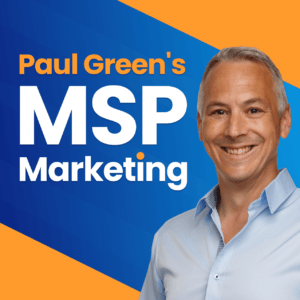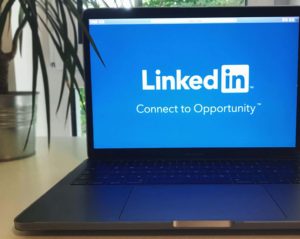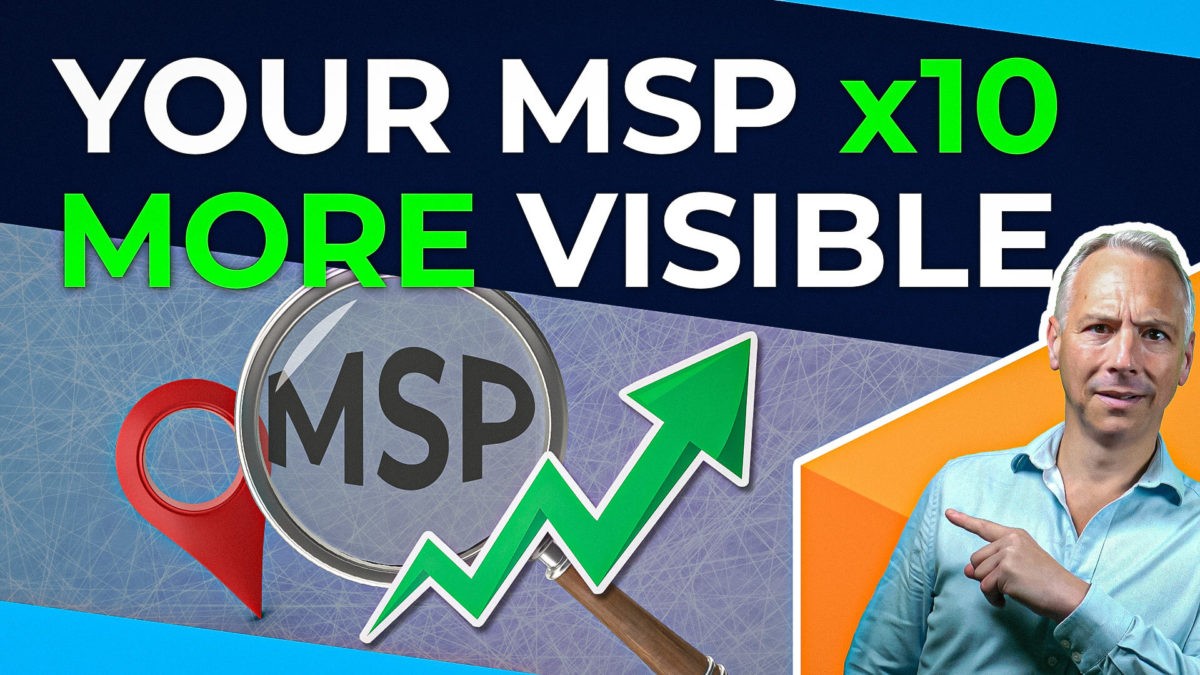
The podcast powered by the MSP Marketing Edge
Welcome to Episode 257 of the MSP Marketing Podcast with me, Paul Green. This week…
- What the yellow car game teaches MSPs about marketing: There’s a part of our brain called the Reticular Activating System which acts as a sensory filter. You might see and hear everything, but you only perceive it if it’s relevant to you.
- Here’s a simple marketing cadence that your MSP can swipe and adapt: How to build a marketing system around repeatable daily, weekly and monthly tasks that will work for any MSP.
- How offering custom development boosts client retention for MSPs: Retaining a client is so much easier than to getting a new one. Is this a potential gap in your MSP’s offering?
- Paul’s Personal Peer Group: Dale, from northeast England, has a website question for his MSP – Should I buy a website domain ending in .io?
What the yellow car game teaches MSPs about marketing
You must often have conversations with ordinary business owners or managers and be gobsmacked just how little they’ve absorbed about stuff from our world, such as cyber security breaches that are in the news or critical updates that need to happen. Have you ever wondered why that is? It’s not just that they don’t care, it’s actually more that their brain has been trained not to tell them about it. You see, the brain has a kind of bodyguard that stops information from getting in and it actually explains why most people don’t perceive your MSP’s marketing. Good news – there is a way around this bodyguard, and the easiest way for me to explain that is to tell you about the yellow car game.
Every time we travel in the car together, my 14-year-old child and I play a really cool game, when we see a yellow car, we have to punch the other person on the arm and the first one to land a punch wins that round. I’m very pleased to tell you that I am the current yellow car champion. Now, this game makes long journeys just whiz by, believe me. And what’s really fun is playing the game with other passengers in the car because my daughter and I absolutely slaughter them. And no wonder because our brains have been trained to actively look for yellow cars, whereas of course our passengers are seeing yellow cars but not perceiving them.

This is because the bodyguard that stops information getting into their brain has not yet been trained to look for yellow cars. Now, this bodyguard has a name, it’s called the reticular activating system, and it has lots of functions, but the most important thing from a marketing point of view is that it acts as a sensory filter. If you had to consciously deal with all of the information coming in from your five senses, you would very quickly go insane. So instead that information goes through the Reticular Activating System, which acts as a relevance filter.
For the small number of things that are relevant to you, it allows you to perceive them. Everything else you might see it or hear it, but you don’t perceive it. And this is why when you go to, let’s say a new town, you see the break/fix shops, you see the vans belonging to other MSPs, because as far as your reticular activating system is concerned they are relevant to you. But you don’t see the dentists and you don’t see the lawyers, unless of course you are marketing to those kind of people, because they are not relevant you. When you understand that everything you do and say to anyone goes through their reticular activating system, and especially your marketing, then you get a blinding realisation why people just don’t seem to take in the things you’re trying to say to them.
And in understanding how the reticular activating system works, there is the clue of how to beat it. Because if the filter is based on relevance, then you have to make the marketing seem more relevant to them.
This is super easy if you operate in a niche and you want to, let’s say, sell to lawyers – you just put the word lawyer in your marketing. Yeah, it really is as simple as that.
It’s a little bit harder with a general audience, but even here you can make your marketing seem more relevant to them. Use your town or city name or use the phrase business owner. As many business owners relate to that.
Anytime you’re doing any marketing at all, writing any words or creating any images, even down to a simple post on LinkedIn, you must be asking yourself this – How do I beat their brain’s bodyguard? How do I wave a massive flag at the reticular activated system to say, Hey, look at me, this is really relevant to your owner’s brain, so please let them perceive this. I think the secret to this is being very, very clear on who your audience is and being very clear what interests them and what doesn’t.
Here’s a simple marketing cadence that your MSP can swipe and adapt
One of the ways to make marketing easy for your MSP is to turn it into a regular system where marketing tasks happen on a specific cadence. Essentially, instead of your marketing being haphazard and relying on you remembering to do it, you turn it into a habit. Let me tell you a really robust cadence that will work for any MSP.
So what is a cadence? Well, it’s a rhythm that you get into, critical if you want to make sure that something happens on a regular basis like your marketing. Far too many MSPs, focus their marketing around one-off campaigns. These can be great, but only if you run them regularly.
You’ve heard that you need seven to 10 touchpoints with a prospect before they’re ready to talk to you, right? Well, you also need to be in front of them at the right time, the exact moment they are ready to think about leaving their incumbent MSP.
That’s really hard to do with one-off campaigns, especially since there’s a ton of work to get the campaign off the ground and then it’s over and it’s too easy to delay the next ton of work to get the next campaign running.
This is why I recommend most MSPs focus on setting up a marketing system. In fact, our MSP Marketing Edge is based around a powerful three-step lead generation system. So here’s a simple marketing cadence you can use in your MSP. It’s based around a series of repeatable tasks that can help you to build multiple audiences, grow a relationship with them, and find a moment they are most open to talking to you, to convert that relationship.

These tasks can be implemented by your team or marketing freelancers working for you. So this starts off with some daily tasks. Daily you’d build your audience by making a number of connection requests on LinkedIn, say 10 of those, and then you’d collect the email address of new connections to add to your email database. Another daily job will be to build relationships by adding content to LinkedIn and commenting on other people’s posts. And another daily task will be to make follow-up phone calls to all of these new people that you are meeting.
Let’s do some weekly tasks. Weekly, I believe you should be sending a LinkedIn newsletter and send it on the same day each week. Also weekly, send an educational email to your database. That’s why you are building up those email connections that we were talking about earlier.
Then let’s go to some monthly tasks. I believe monthly you should run a marketing campaign, but do one every month aimed at your hottest prospects. Don’t send a campaign to a prospect every month. They might get two or three a year, but every month you can target some prospects with a campaign. And monthly you can ship a printed newsletter to your hottest prospects. That you can do every single month if you wanted to. Which of these repeatable marketing tasks do you think would work best for your MSP?
How offering custom development boosts client retention for MSPs

Featured guest: George Toursoulopoulos is a CEO and technology leader with over 20 years of experience in the software development industry. As the founder and CEO of Synetec, George has built a reputation for delivering innovative software solutions that drive business growth and operational efficiency.
George’s expertise spans across strategic leadership, digital transformation, and fostering high-performing teams. Passionate about helping businesses leverage technology to solve complex challenges, George is dedicated to ensuring that Synetec’s clients achieve measurable success through tailored software solutions.
The idea of offering custom software development to your clients might be the worst thing you’ve ever heard, because that means managing expectations, crazy complicated development plans, and of course developers. But my special guest today believes you have to, and not just as a profit centre, but as a client retention strategy.
Today’s guest believes your clients see software development just like they see websites. To them, it’s all just technology and they would rather buy it from you, but if they can’t, maybe they’ll go somewhere else for it.
Hi, I’m George Toursoulopoulos, CEO of Synetec.
George, thanks for coming onto the podcast. You are perhaps the best example of why I always ask our guests to introduce themselves so I never have to learn how to pronounce difficult surnames. It’s a delight to have you on here. You were recommended by two or three separate people to come on and talk about a very interesting subject – why MSPs should offer software development.
We’re going to be exploring that in just a few minutes time, and I know that you believe very strongly that for client retention reasons, every MSP should be offering software development. Let’s first of all, just go back a few steps and let’s learn a little bit about you. So tell us what you do now, but more importantly, how did you get into software development?
That’s a great question. I mean, I’ve always been in software development, I studied it, so my background is in that. But I suppose what’s been interesting is I’ve worked for clients and then found what was being done in terms of how they could get it right, how they could get it wrong. So it was always a natural progression to start my own company and help them get it right, so to speak.
And obviously you’re running your own software development company now. Is this something you’ve always done or have you worked for other people doing the same thing?
When I first got out of uni, I was working for quite a big outsourcing company from the states, EDS, for quite a few years. Sort of learned my trade there, so to speak. And then I founded a company actually over in South Africa, which I sold and came over to the UK. And after a couple of years consulting, I started up Synetec in 2009. So we’ve been running for about 15 years now.
And over those 15 years, of course, the whole concept of software development is completely different, isn’t it?
Absolutely. I mean, it’s changed. It’s been huge. I mean, the way development is done and how companies are comfortable doing development themselves and not to mention Covid, Covid made a massive difference in terms of working remotely and how comfortable people were with that. So we’ve had a couple of little industrial revolutions within the software development business over the last 15 years.
I bet you have. And just before we talk about how MSP should be using software development, as you look at the rise of the AI models and things like no-code coding, both of which are concepts I don’t really understand a huge amount about, but I do read about them as I’m sure lots of ordinary business owners do. How do you see software development changing over the next 15 years or so?
Everyone’s talking about AI, right? I mean that’s almost, I wouldn’t say a given, but it’s obviously very exciting. The precursor is the data though. So the interesting thing is there’s a ton of work that has to be done structuring and cleaning up that data. And one of the interesting things is everyone wants clean data, but no one wants to pay for it. So I think that’s a massive blocker. We’ve got to figure out how to be able to do that properly before then the AI adoption is really going to grow and pick up pace.
Yes, I think that’s a fair thing to say. So let’s look now at MSPs and software development. And they’re not really two things that a number of years ago I would’ve put together. But in fact, you are not just the first person, you’re one of a growing number of people that have said to me, actually these days, we believe that software development is a service that MSPs should be offering. Can you give us some examples of why it’s so important for MSPs to at least be able to have those conversations with their clients?
It’s definitely something that’s changing and becoming more intense over the last year, certainly. I mean, for us, we work closely with quite a number of MSPs. And we’ve had a couple of times where clients have left their MSP, even though the MSP is doing really well in different ways and really giving them great service, but they’re leaving them because the need that they have, that crosses over to where they see the MSP should be offering those services, their MSP is saying, no, we don’t do that. And then what happens is the client then says, well, I’m going to go somewhere where I’m going to be serviced.
So I think that as a business owner, I’d say that’s the number one reason for us to do anything, isn’t it? Client retention. How much more easy is it to retain a client than to get a new one?
So we’ve got to be able to look after our clients. I think that’s something that’s really on the increase. I understand why that is, but the point is it’s definitely on the increase.
So I imagine from the ordinary business owner or manager’s point of view, they see software development as an IT thing, and I’m putting that in kind of little speech marks in the same way that they probably see their website as an IT thing. We of course know that websites and tech support and cyber security and software development are all completely different areas. And from the MSPs that you’re working with when they first start talking to you about offering software development, are they nervous because they don’t see it something within their skillset?
Yeah, very much so. And I think the challenge with software development is it often gets a bad rap because it can be badly done. And I think anything that’s service orientated, I mean look at the building industry, how many people actually say – I’ve got a great builder, everything was on time and on budget and was wonderful? I think software development falls into that because the requirements aren’t static and clear upfront. So I think MSPs generally have two main concerns. Number one is, we don’t want a happy customer turning into an unhappy customer and there’s potential risk there, and two, we don’t really know how to do it, it’s a completely different business line.
I think that kind of sums it up for me, but I think the bigger challenge that almost overrides those is that the crossover between development infrastructure is so big that you cannot properly support a client if you don’t know what they’re going to do with that infrastructure when it comes to the development. And I think fundamentally for companies that are perhaps under-skilled with not just plain software development, but with the sort of the DevOps roles around the development team, what then happens is something that an MSP is provisioned for a customer is now sort of bundled under them. They go, well, we got this stuff off you, but we’re not using it well, we’re wasting money, this is your fault. Or we need this and now you can’t do it for us. If that makes sense.

Yeah, yeah, that makes perfect sense. And when we’re talking about development, are we talking about you as the MSP, whether you do it in-house or whether you outsource it to a company such as yours? Are we talking about taking bespoke development that they’ve had done elsewhere, perhaps some kind of legacy application they’ve had built, or are we talking about brand new development or is it a bit of a mix of both?
I think it’s a mix of both. When MSPs get new clients by a client turning around and saying, okay, we’re going to move from on-prem, let’s say to public cloud. That’s a typical entry point from my conversations with the companies we work with. And at that point, if there’s any bespoke applications, one of the key parts of that migration or concerns is going to be how are we going to migrate this onto the public cloud from our on-prem service? Typically speaking, the MSP will say, well, we’ll give you the infrastructure and you sort that out. So it’s a differentiator when winning completely new clients, that’s the one side. When they’re an existing client, you have a position of trust, almost a trusted advisor, which is fantastic. That’s the position you want to be in, so you can really help look after them.
So when they need something brand new that you just mentioned, they want to know, who do you recommend for this? You want to be able to give a good recommendation if you can’t do it yourself or you want to have a good partner. So you keep that in your ecosystem. Alternatively, if they have something internally and they perhaps have their own development function. Typically speaking, I’m not talking about the very large institutions. I’m, let’s say, talking about a company that has, let’s say less than 50 developers. So a medium size to small size enterprise, they’re going to be missing key skill sets. And specifically if they’re giving the MSP the infrastructure support role, they will be missing those roles that stereotypically used to work within the development team to help them give the development team what they have. So that gap is there now.
And that’s obviously an opportunity there to fill that gap. George, final question for you. Tell us about either the biggest headache or the worst project or the oldest legacy code you’ve worked on or some kind of funny story from your career or something that you looked at initially and thought, we’re never going to be able to cope with this
Funny, this will reduce you to tears or laughter, you have to pick one or the other. I think typically speaking, we’ve actually got a client that has undergone quite a large project transformation where they used to have four or five different PCs all connecting to this main server, all running these separate applications that were then pumping data into the main database. And these guys were running an absolute fortune in terms of it was a hedge fund that was running a huge amount of money. And if one of these PCs were ever switched off, the whole thing would just break. And one day, apparently the cleaner came in and one of the PCs was unplugged, so everything didn’t work the next day. I mean funny, but also really concerning. Anyway, we helped them transform and get away from that kind of environment. But the stories you see like that and how much sometimes sticky tape and wires holding everything together is quite amusing,
And it does make you wonder how many more of those situations are still out there just waiting for someone to come along and take it, fix it, and do it before the cleaner switches everything off. Tell us a little bit about Synetec. What do you do for MSPs and what’s the best way to get in touch with you, George?
So we work with MSPs to help them fill that gap in infrastructure. We help them service their clients when they have a development function. We help them procure the infrastructure that they need, but also set it up correctly and make it part of their internal processes. So we fill that gap between the MSPs and the internal development teams. We also help them when it comes to data management and structuring of data, putting data links and databases together. So we have quite a good relationship with multiple MSPs that we can help in that way. And the best way to get hold of me is just email me gtours@synetec.co.uk, or you can go on to our website, www.synetec.co.uk or just message me on LinkedIn.
Paul’s Personal Peer Group
This week’s question comes from Dale, who is based in the northeast of England, and is soon going to change the name of his MSP. His question is – Should I buy a website domain ending in .io?
Ideally, no, because on the whole people like us are more comfortable with io or other unusual top level domains because we see them all the time. The question to ask – Is your target audience, i.e. ordinary people, comfortable with .io or will it confuse them? Because confusion kills sales. Where you can, stick to .com or one specific to your country, such as .co.uk.
Mentioned links
- This podcast is in conjunction with the MSP Marketing Edge, the world’s leading white label content marketing and growth training subscription.
- Join me in MSP Marketing Facebook group.
- Connect with me on LinkedIn.
- Connect with my guest George Toursoulopoulos on LinkedIn and check out his website.
- Got a question about your MSP’s marketing? Submit one here for Paul’s Personal Peer Group.
